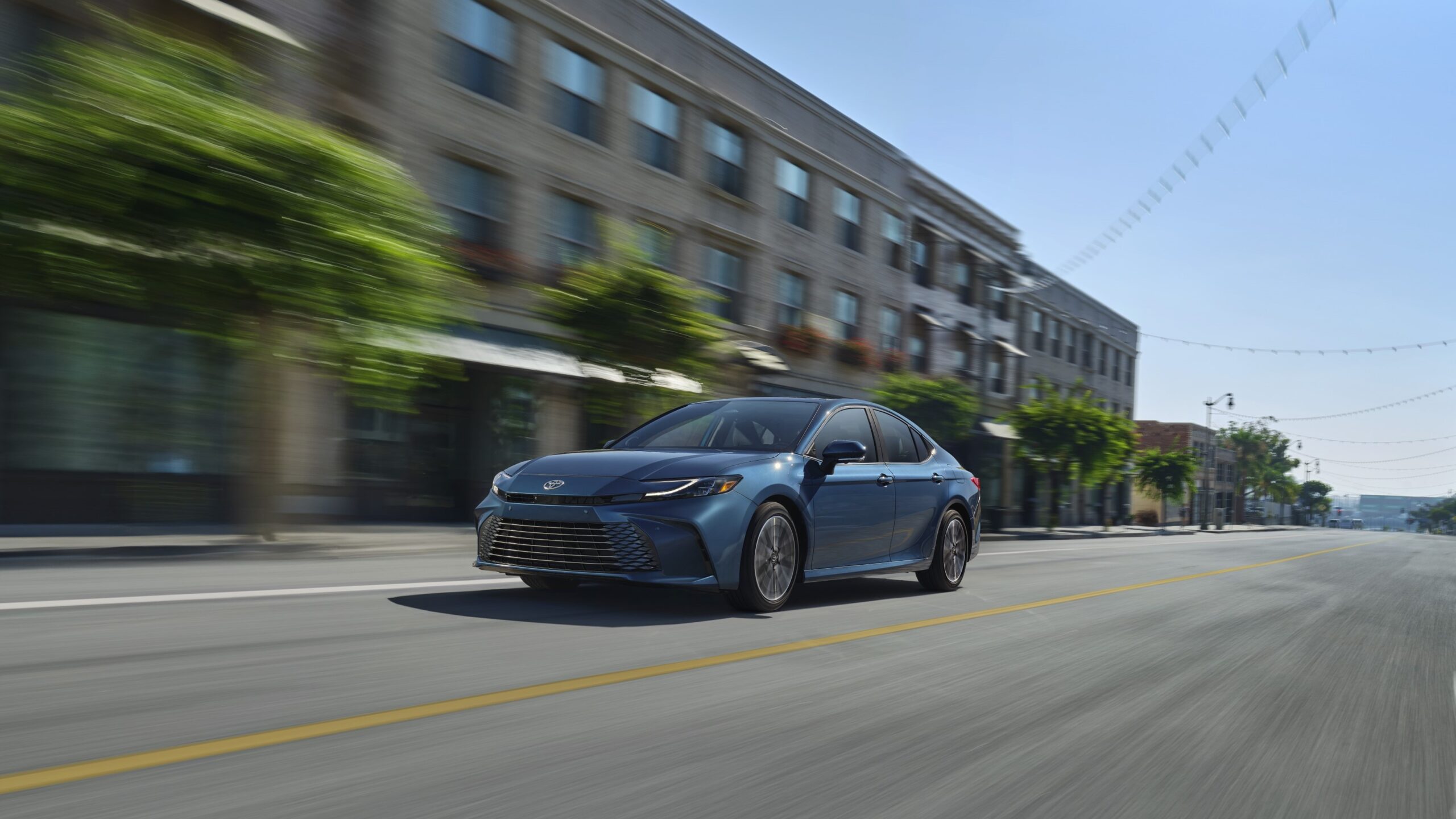2025 Toyota Camry Hammerhead Headlamp, A Head-Turning Design

Today, we dive deep into a discussion between a few of the head engineers at Toyota as they unveil the process of creating the all-new 2025 Toyota Camry Hammerhead Headlamp design. This redesigned headlamp was inspired by Hammerhead sharks and is very eye-catching, probably one of the first things you’ll notice about the Camry for 2025.
Table of Contents
2025 Toyota Camry Hammerhead Headlamps and Race-Inspired Front Fascia
All 2025 Toyota Camrys will come with LED Hammerhead Headlamps, and each grade will also wear a distinct grill true to its character. The XSE and SE grades will feature a body-color match sports grill, race-inspired, functional aerodynamic air ducts, and front-side canards. Let’s get back to what you came for: the headlamps.
Camry Hammerhead Headlamp Design Process Explained by Mark Dejongh, Camry, Cheif Engineer
“There’s always challenges on headlamps. I think almost every vehicle that I’ve been a part of, headlamps are always a challenge area because you’re balancing so many things.
There’s really high expectations for headlamps from the customers today. Because so many vehicles have really upped the game. For the Next Generation Camry, the hammerhead styling theme was really important.”
Here, Mark Dejongh explains the challenges of this new headlamp design due to the spacing for effectiveness versus keeping the head-turning design elements that the engineering team is looking for on the 2025 Toyota Camry Hammerhead Headlamp.
“What it does is it pushes the lamps way out to the corners. And you’ll see that there’s actually very little space left for the actual lamps. Of course you have to have the light output because the light output has got to be beautiful and uniform. So it was really challenging to both meet styling intention of this kind of great hammerhead shape and to get the light output.”
Mark Dejongh points out a major concern for the 2025 Toyota Camry Headlamps.
“So when we’re driving the vehicle at night, we’re looking for uniformity. Is this a nice even light, or do you see like hot spots like, oh, it’s kind of bright here, and it’s dim here, it’s bright there?
And the engineers did such a good job of making sure that uniform appearance was there. We almost had to give up with that hammerhead theme because we’re out of time.
We don’t have time to continue to develop this DRL (Daytime Running Lamp). And I said, you’ve got two weeks, and that’s it. And I’m so glad that they gave it that one last shot because it looks incredible. When it’s unlit, it looks really good. And then, when it’s lit, it has this cool signature DRL appearance. Uniform bright white light that kind of makes this kind of C shape.
Honestly, it always boggles my mind how the engineers do it. It’s really amazing if you look at a lot of the plan view of where that light is going. It’s really incredible that how they’re able to precisely put this light exactly where it needs to be.”

Camry Hammerhead Challenges, Sunil Dalal, Vehicle Mobility, Principal Engineer
“This vehicle is loaded in a condition as if a driver is driving it, and from here on, we’ll measure, aim the lamps, and then measure the output.”
Sunil Dalal also goes on to explain:
“We are evaluating performance in the true driver condition. How the end customer will be using this vehicle, and how will they experience the performance of the vehicle?”
“For the design to achieve the performance, we design and set targets, which are part of tonight’s drive as well. And this area, so we want to reduce the light for the oncoming vehicle lane so they don’t get glare but have a good reach for the driving lane.
We see a long reach. If there are any issues identified, we highlight those issues. And further, refine the design so that we can close those gaps and give the performance that customer expects from Toyota.”

Benefits of the 2025 Toyota Camry Hammerhead Headlamps
Hammerhead Styling Theme: The design pushes the lamps to the corners of the vehicle, creating a distinctive hammerhead shape.
Light Output Design: Focused on achieving beautiful and uniform light distribution, ensures even lighting without hot spots or uneven brightness.
Targeted Light Reduction for Oncoming Vehicles: This minimizes glare for oncoming traffic while maintaining good visibility for the driver.
Improved Aesthetics: The hammerhead design serves a functional purpose and adds a unique aesthetic appeal to the vehicle.
Customer-Centric Design: Emphasis on the driver’s experience and perception of light quality and distribution.
Adaptive Light Control: Adjustments can be made for different driving conditions, enhancing the overall driving experience.
Toyota Safety Sense 3.0
Now standard across the lineup are Blind Spot Monitors (BSM) with Rear Cross-Traffic Alert (RCTA) for a safer, more convenient driving experience. New Traffic Jam Assist (TJA) facilitates stop-and-go driving on congested roads by controlling acceleration, braking, and steering within a speed range of 0 to 25 mph. Toyota Safety Sense (TSS) is an advanced suite of safety features designed to keep drivers and passengers safer on the road. These innovative technologies help avoid accidents altogether. Here is a list of components within the suite:
- Pre-Collision System (PCS): Detects vehicles, pedestrians, cyclists, and motorcyclists, providing warnings and emergency braking if needed.
- Lane Departure Alert (LDA): Warns drivers of unintentional lane departure and may provide corrective steering.
- Dynamic Radar Cruise Control (DRCC): Maintains a set distance from the vehicle ahead, adjusting speed accordingly.
- Lane Tracing Assist (LTA): Keeps the vehicle centered in its lane using lane markers and preceding vehicles.
- Automatic High Beams (AHB): Automatically switches between high and low beams based on surrounding traffic.
- Road Sign Assist (RSA): Detects and displays road signs to enhance driver awareness.
- Proactive Driving Assist (PDA): Provides braking or steering support to maintain distance and stay in lane.
Toyota Connected Services
Toyota Connected Services offers a range of convenient features for most late-model Toyota vehicles, accessible through an active trial or subscription. These services are designed to enrich the driving experience, providing the ability to stay connected even while driving. To learn more about Toyota Connected Services, visit: https://www.toyota.com/connected-services/
- Safety Connect: Offers emergency assistance, roadside help, and automatic collision notifications to ensure driver and passenger safety.
- Service Connect: Provides vehicle health reports and maintenance updates directly to your email or mobile app, helping you keep your Toyota in top condition.
- Remote Connect: Allows you to control specific vehicle functions remotely, such as starting the engine, locking/unlocking doors, and locating your vehicle, all from your smartphone or smartwatch.
- Wi-Fi Connect: Turns your vehicle into a mobile hotspot, enabling you to connect multiple devices to the internet for streaming, browsing, and staying connected.
- Dynamic Navigation: Offers updated maps, real-time traffic information, and dynamic route guidance to help you reach your destination efficiently.
- Destination Assist: Connects you with a live agent who can help find locations and send directions directly to your vehicle’s navigation system.
- Drive Connect Cloud Navigation: Offers advanced connectivity, including Cloud Navigation for real-time traffic, automatic map updates, and voice-activated searches. Enhances driving with up-to-date information, offline capabilities, and customizable map views, all integrated into Toyota’s multimedia system.
- Wireless Apple CarPlay® & Wireless Android Auto: Allows for seamless integration of your smartphone, giving you access to apps, music, messages, and more through the vehicle’s touchscreen display.
- Insure Connect (TIMS): offers Toyota owners easy access to insurance through the Toyota App or Dealer Daily, featuring OEM part repairs, various discounts, and comprehensive coverage options beyond just vehicles.
Availability can vary by vehicle model and region; some services may require a subscription.
Recap of the Camry Hammerhead Headlamps
This interview highlights the complex balance between aesthetics, safety, functionality, and customer experience that the engineers aimed to achieve with this new headlamp design. The discussion underscores the balance between innovative design and functionality, plus the difficulty of bringing it to reality.
Images courtesy of Toyota Pressroom
Frequently Asked Questions
The Hammerhead design positions the headlamps at the vehicle’s corners, creating a distinctive hammerhead shape. This not only adds to the aesthetic appeal of the Camry but also poses a unique challenge in integrating effective lighting within the design constraints.
The headlamps are designed with a focus on uniform light distribution and long reach, reducing glare for oncoming traffic while enhancing the driver’s visibility.
Engineers use an optical axis mark and laser positioning to aim the headlamps accurately. This precision ensures optimal alignment and light distribution.
Yes, the headlamps are evaluated under true driver conditions to simulate how customers will experience the vehicle’s performance in typical driving scenarios.
The headlamp design includes targeted light reduction in the lane of oncoming vehicles to minimize glare. This feature improves safety for all road users.
The DRL feature is a design element that, when unlit, adds to the vehicle’s aesthetic appeal and, when lit, offers a distinctive, uniform, bright white light in a C-shape pattern.
Absolutely. The design and evaluation of the headlamps were heavily focused on the driver’s experience, particularly in terms of light intensity and reach.
The engineering is notable for its ability to precisely control and distribute light exactly where needed, despite design and space constraints, which reflects advanced technological and engineering capabilities.
Note: Always refer to the vehicle’s Owner’s Manual for more detailed information about your specific vehicle. Safe driving practices should always be followed. For more details, contact your local Toyota Dealer or visit Toyota.com.

Cedric Jackson
Cedric is a Sales Pro with 20+ years of experience. He is currently a Sales Consultant at Toyota of Riverside. He aims to share his passion for product knowledge of the Toyota brand here on his blog. Cedric writes content here and produces short-form videos on YouTube, Instagram & TicTok. Connect with him here or on all social media @ cedricthecarguy 🙏🏾🤙🏾

Cedric Jackson
Cedric is a Sales Pro with 20+ years of experience. He is currently a Sales Consultant at Toyota of Riverside. He aims to share his passion for product knowledge of the Toyota brand here on his blog. Cedric writes content here and produces short-form videos on YouTube, Instagram & TicTok. Connect with him here or on all social media @ cedricthecarguy 🙏🏾🤙🏾

